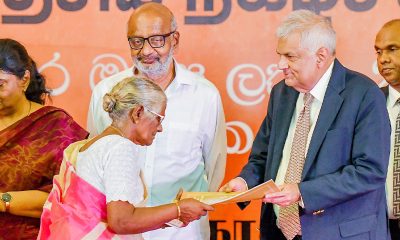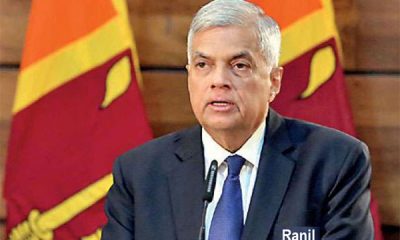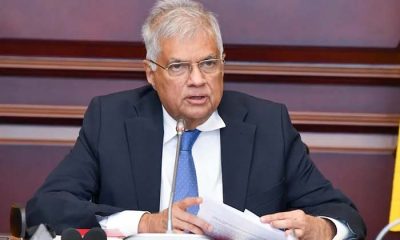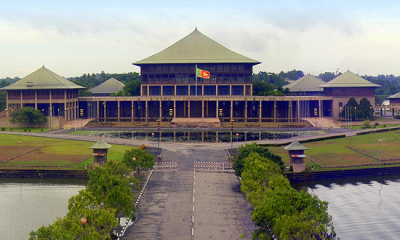Features
1983: It haunts us still!
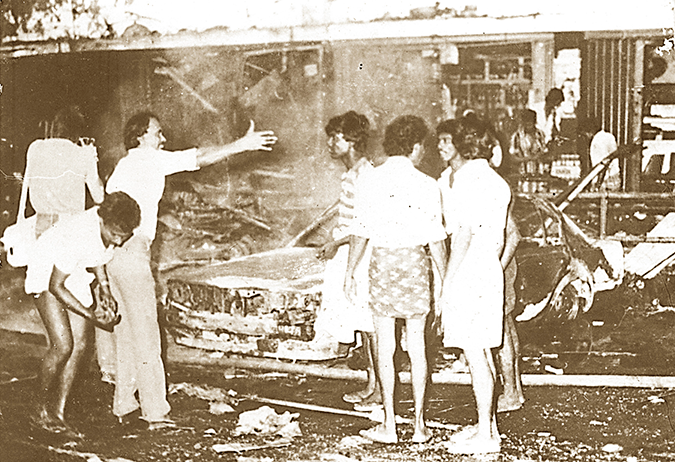
by Rajan Philips
The historical memories of 1915, 1958, 1977, 1981 and 1983 have far outlived their experiences and their victims. The year 1983, with its pre-meditated rehearsal in 1981, was different from its predecessors in many different ways. The extent of its horror was unprecedented and was only matched by the helplessness of its victims and the unhelpfulness of those who had the power and the responsibility not only to stop the catastrophe but also to protect the victims. The aftermaths of 1983 have been even worse and far more consequential.
The first to occur under a presidential government and in the wake of a referendum that fossilized an existing parliament, the 1983 violence spawned a civil war that lasted decades and the ending of which is still mired in controversy, with claims and counterclaims which are repeated not for resolution but for mutual aggravation. Far from war being the continuation of politics with gunfire, politics has become the continuation of war without gunfire.
Tragic1983 triggered if not a massive but a significant exodus of Sri Lankan Tamils who are now a far flung part of the universe of global diasporas that cannot let go of their love-hate connections with the old countries. In love with whatever they left behind, and hateful of whatever forced them to leave. It precipitated the second JVP insurrection in the south but with no synchronization with the war in the north.
The ultimate upshot was the involvement of India which included the Indian army, a bilateral agreement between India and Sri Lanka, and the unusually long and overly detailed 13th Amendment that has provided a permanent forum for endless debates and not a practical framework for easy implementation.
There has been no official recollection of the 40th anniversary of 1983 in Colombo. None was expected. Nor was there any reference to it in New Delhi during the state visit of President Wickremesinghe. Some found it surprising, if not transformative. In fact, there was no official mention of the 13th Amendment during the visit. The joint statement, entitled “Promoting Connectivity, Catalysing Prosperity: India-Sri Lanka Economic Partnership Vision,” is a statement of vision for co-operation and investments in five areas: maritime, air, energy, trade and people-to-people initiatives.
The Hindu (July 25) editorial pointed out the conspicuous omission of any acknowledgement of “previous commitments by Sri Lanka on honouring the 13th Amendment for devolution of powers to the North and Eastern provinces, and for resolving the long-pending issues over arrest of Indian fishers.” The only reference to devolution and Provincial Council elections were in the speech of Prime Minister Modi. There was no mention of them, let alone a re-commitment, by President Wickremesinghe.
The lack of acknowledgment is seen by The Hindu as “the bigger message from the meeting: that despite Sri Lanka’s other dependencies on New Delhi, the Indian government is no longer welcome to bring its historical concerns over the Tamil issue into bilateral negotiations.” And it could also be seen as the “point of positive transformation in the relationship” between the two countries, that Foreign Secretary Vinay Kwatra had been announcing that the visit would accomplish.
All of this should be a transformative wake up call for Tamil political leaders whose political strategy has been to rely on the persistence of Modi and the goodwill of Wickremesinghe. They have no other leverage over decision making on substantive matters involving power devolution or provincial administration. If The Hindu editorial interpretation is correct, New Delhi now seems reconciled to avoiding any reference to devolution in bilateral transactions. That would make the Sri Lankan Tamil leaders even more helpless. But they have plenty of other means to cause perpetual annoyance to any government in Sri Lanka.
Genocide Annoyance
One source of annoyance to the Sri Lankan government is UNHRC in Geneva. The biggest source of annoyance, however, is Canada, home to the largest presence of Sri Lankan Tamils, and as direct an aftermath of 1983 as there can be. Prime Minister Trudeau may be the only government leader in the world to formally commemorate in his county the Black July tragedy of 1983 in Sri Lanka. This has become an annual occurrence in Canada, and is observed by both Liberal and Conservative Prime Ministers. In his statement on 23 July, Mr. Trudeau again raised the spectre of genocide that would have raised more than a few hackles in Colombo. He spoke of the motion that the Parliament of Canada unanimously adopted last year to make May 18 Tamil Genocide Remembrance Day, which was observed for the first time this year.
The resolution by the Canadian parliament is a sequel to the legislation passed by the Ontario provincial legislature, in 2021, proclaiming a week in May (ending on May 18) to be observed each year as Tamil Genocide Education week. The constitutionality of the Ontario legislation, the Tamil Genocide Education Week Act (TGEWA) was challenged in the Ontario Superior Court of Justice by two Sri Lankan-Canadian organizations and two individuals.
The appeal was dismissed by Justice JT Akbarali in a comprehensive ruling that addressed some larger questions raised against a short and simple piece of legislation. He made it clear that he was making “no findings about whether there was, or was not, a Tamil genocide in Sri Lanka,” but he was ruling only on the constitutionality of the law and the jurisdictional competence of the Ontario legislature to pass it.
Justice Akbarali also noted that while the Ontario legislation recognizes Tamil genocide, “it is not recognition for recognition’s sake” but for the purpose education in order to, among other things, “create the conditions for Tamil Ontarians to share their stories and begin to heal from the trauma and inter-generational trauma.” The notion of healing from trauma offers a sympathetic approach to dealing with the vexed question of genocide instead of a severely legalistic approach of proving or disproving genocide.
Genocide is a loaded term that can be loosely used or rejected, and people use it or reject it depending on their experiences and their perceptions, not to mention their political locations. People will use it inasmuch as there is a cathartic dimension to it. From that standpoint, trying to stop the use of the term through court challenges or diplomatic protests will prove to be futile.
Literary Turn
The sources and effects of trauma multiplied in Sri Lanka during the two decades of war following 1983. The responses to trauma are also manifesting in multiple ways, and creative writing is now one of the more positive avenues of response to trauma. Fictional writing and performing arts have become infectious and have elicited talented contributors from among the Tamils, Sinhalese and Muslims regardless of whether they are located in the diaspora or living in the old country.
Literature arising from the ashes of political violence can be more than therapeutic. Parul Sehgal writing in the New Yorker (January 2023) to mark the 75th anniversary of the Partition of India, alludes to the consensus among writers and scholars that “the fullest account of 1947 could be found not in facts and figures – not in non-fiction at all – but in in texts like ‘Tamas,’ in literature.” She cites Ayesha Jalal, the Pakistani-American Historian, and in whose view, “creative writers have captured the human dimensions of Partition far more effectively than historians.”
In Abiding by Sri Lanka, Qadri Ismail advocated taking a ‘literary turn’ in politics, by reading fiction against the social sciences; by reading fiction to critique the ethos and practices of identity, nationalism and representative democracy; and for drawing on literary insights to imagine political possibilities.
We miss Qadri now to give us his inimitably critical take on the literary outputs on Sri Lanka that are emerging from Australia to America, to tell us the human dimensions captured by these writings which are missed in the claims and counterclaims about body counts, and to extract for us whatever insights there might be to compensate for the political drought that we are constrained to suffer under the weight of the economic mess that the war hero Gotabaya has left us with.
Turning to Politics
To return to politics, President Wickremesinghe has not lost the capacity to surprise even though he has been in politics for a boringly long time with boringly little to show for it. After being mum about devolution during his visit to New Delhi, the President convened an All Party Conference soon after his return to discuss the 13th Amendment and its implementation.
The reported purpose of the conference was to update the party leaders in parliament on the President’s National Reconciliation Program and the North-East Development plan. The reports did not indicate whether or not the President updated his parliamentary supplicants on his visit to India and the outcomes of his meetings with Prime Minister Modi.
Instead, the conference was another occasion for the President to lecture party leaders on the role of the parliament in implementing the proposals he would bring forward for the betterment of the country. Specific to Provincial Councils, the President repeated the old call for all-party support to devolve powers to Provincial Councils.
But how can the President call for and expect all-party support when he will not agree to anything that any or all of the political parties have been asking ever since he became caretaker President? The list is long, but it is enough to mention local government elections, provincial elections, as well as parliamentary elections.
The President is also reported to have presented a seemingly new proposal – for provincial councillors to double as parliamentarians, and for MPs to serve on provincial councils. Where is this coming from? Is this another clever-by-half move, to send MPs to provincial councils to restart them without elections? After the non-starter backdoor attempt to resurrect the dead local bodies without any new elections?
That is the current state of Sri Lankan politics – 40 years after 1983, 36 years to this day (29 July) after the Indo-Sri Lanka Peace Accord, and 14 years after the end of the war. And that is how 1983 is different from the episodes that came before it. After 1915, 1958, and even 1977, the state and the government were able to restore normalcy quite substantially in a relatively short order. That has not been the case after 1983, and there are no signs that anything will change any time soon.
Features
The heart-friendly health minister

by Dr Gotabhya Ranasinghe
Senior Consultant Cardiologist
National Hospital Sri Lanka
When we sought a meeting with Hon Dr. Ramesh Pathirana, Minister of Health, he graciously cleared his busy schedule to accommodate us. Renowned for his attentive listening and deep understanding, Minister Pathirana is dedicated to advancing the health sector. His openness and transparency exemplify the qualities of an exemplary politician and minister.
Dr. Palitha Mahipala, the current Health Secretary, demonstrates both commendable enthusiasm and unwavering support. This combination of attributes makes him a highly compatible colleague for the esteemed Minister of Health.
Our discussion centered on a project that has been in the works for the past 30 years, one that no other minister had managed to advance.
Minister Pathirana, however, recognized the project’s significance and its potential to revolutionize care for heart patients.
The project involves the construction of a state-of-the-art facility at the premises of the National Hospital Colombo. The project’s location within the premises of the National Hospital underscores its importance and relevance to the healthcare infrastructure of the nation.
This facility will include a cardiology building and a tertiary care center, equipped with the latest technology to handle and treat all types of heart-related conditions and surgeries.
Securing funding was a major milestone for this initiative. Minister Pathirana successfully obtained approval for a $40 billion loan from the Asian Development Bank. With the funding in place, the foundation stone is scheduled to be laid in September this year, and construction will begin in January 2025.
This project guarantees a consistent and uninterrupted supply of stents and related medications for heart patients. As a result, patients will have timely access to essential medical supplies during their treatment and recovery. By securing these critical resources, the project aims to enhance patient outcomes, minimize treatment delays, and maintain the highest standards of cardiac care.
Upon its fruition, this monumental building will serve as a beacon of hope and healing, symbolizing the unwavering dedication to improving patient outcomes and fostering a healthier society.We anticipate a future marked by significant progress and positive outcomes in Sri Lanka’s cardiovascular treatment landscape within the foreseeable timeframe.
Features
A LOVING TRIBUTE TO JESUIT FR. ALOYSIUS PIERIS ON HIS 90th BIRTHDAY

by Fr. Emmanuel Fernando, OMI
Jesuit Fr. Aloysius Pieris (affectionately called Fr. Aloy) celebrated his 90th birthday on April 9, 2024 and I, as the editor of our Oblate Journal, THE MISSIONARY OBLATE had gone to press by that time. Immediately I decided to publish an article, appreciating the untiring selfless services he continues to offer for inter-Faith dialogue, the renewal of the Catholic Church, his concern for the poor and the suffering Sri Lankan masses and to me, the present writer.
It was in 1988, when I was appointed Director of the Oblate Scholastics at Ampitiya by the then Oblate Provincial Fr. Anselm Silva, that I came to know Fr. Aloy more closely. Knowing well his expertise in matters spiritual, theological, Indological and pastoral, and with the collaborative spirit of my companion-formators, our Oblate Scholastics were sent to Tulana, the Research and Encounter Centre, Kelaniya, of which he is the Founder-Director, for ‘exposure-programmes’ on matters spiritual, biblical, theological and pastoral. Some of these dimensions according to my view and that of my companion-formators, were not available at the National Seminary, Ampitiya.
Ever since that time, our Oblate formators/ accompaniers at the Oblate Scholasticate, Ampitiya , have continued to send our Oblate Scholastics to Tulana Centre for deepening their insights and convictions regarding matters needed to serve the people in today’s context. Fr. Aloy also had tried very enthusiastically with the Oblate team headed by Frs. Oswald Firth and Clement Waidyasekara to begin a Theologate, directed by the Religious Congregations in Sri Lanka, for the contextual formation/ accompaniment of their members. It should very well be a desired goal of the Leaders / Provincials of the Religious Congregations.
Besides being a formator/accompanier at the Oblate Scholasticate, I was entrusted also with the task of editing and publishing our Oblate journal, ‘The Missionary Oblate’. To maintain the quality of the journal I continue to depend on Fr. Aloy for his thought-provoking and stimulating articles on Biblical Spirituality, Biblical Theology and Ecclesiology. I am very grateful to him for his generous assistance. Of late, his writings on renewal of the Church, initiated by Pope St. John XX111 and continued by Pope Francis through the Synodal path, published in our Oblate journal, enable our readers to focus their attention also on the needed renewal in the Catholic Church in Sri Lanka. Fr. Aloy appreciated very much the Synodal path adopted by the Jesuit Pope Francis for the renewal of the Church, rooted very much on prayerful discernment. In my Religious and presbyteral life, Fr.Aloy continues to be my spiritual animator / guide and ongoing formator / acccompanier.
Fr. Aloysius Pieris, BA Hons (Lond), LPh (SHC, India), STL (PFT, Naples), PhD (SLU/VC), ThD (Tilburg), D.Ltt (KU), has been one of the eminent Asian theologians well recognized internationally and one who has lectured and held visiting chairs in many universities both in the West and in the East. Many members of Religious Congregations from Asian countries have benefited from his lectures and guidance in the East Asian Pastoral Institute (EAPI) in Manila, Philippines. He had been a Theologian consulted by the Federation of Asian Bishops’ Conferences for many years. During his professorship at the Gregorian University in Rome, he was called to be a member of a special group of advisers on other religions consulted by Pope Paul VI.
Fr. Aloy is the author of more than 30 books and well over 500 Research Papers. Some of his books and articles have been translated and published in several countries. Among those books, one can find the following: 1) The Genesis of an Asian Theology of Liberation (An Autobiographical Excursus on the Art of Theologising in Asia, 2) An Asian Theology of Liberation, 3) Providential Timeliness of Vatican 11 (a long-overdue halt to a scandalous millennium, 4) Give Vatican 11 a chance, 5) Leadership in the Church, 6) Relishing our faith in working for justice (Themes for study and discussion), 7) A Message meant mainly, not exclusively for Jesuits (Background information necessary for helping Francis renew the Church), 8) Lent in Lanka (Reflections and Resolutions, 9) Love meets wisdom (A Christian Experience of Buddhism, 10) Fire and Water 11) God’s Reign for God’s poor, 12) Our Unhiddden Agenda (How we Jesuits work, pray and form our men). He is also the Editor of two journals, Vagdevi, Journal of Religious Reflection and Dialogue, New Series.
Fr. Aloy has a BA in Pali and Sanskrit from the University of London and a Ph.D in Buddhist Philosophy from the University of Sri Lankan, Vidyodaya Campus. On Nov. 23, 2019, he was awarded the prestigious honorary Doctorate of Literature (D.Litt) by the Chancellor of the University of Kelaniya, the Most Venerable Welamitiyawe Dharmakirthi Sri Kusala Dhamma Thera.
Fr. Aloy continues to be a promoter of Gospel values and virtues. Justice as a constitutive dimension of love and social concern for the downtrodden masses are very much noted in his life and work. He had very much appreciated the commitment of the late Fr. Joseph (Joe) Fernando, the National Director of the Social and Economic Centre (SEDEC) for the poor.
In Sri Lanka, a few religious Congregations – the Good Shepherd Sisters, the Christian Brothers, the Marist Brothers and the Oblates – have invited him to animate their members especially during their Provincial Congresses, Chapters and International Conferences. The mainline Christian Churches also have sought his advice and followed his seminars. I, for one, regret very much, that the Sri Lankan authorities of the Catholic Church –today’s Hierarchy—- have not sought Fr.
Aloy’s expertise for the renewal of the Catholic Church in Sri Lanka and thus have not benefited from the immense store of wisdom and insight that he can offer to our local Church while the Sri Lankan bishops who governed the Catholic church in the immediate aftermath of the Second Vatican Council (Edmund Fernando OMI, Anthony de Saram, Leo Nanayakkara OSB, Frank Marcus Fernando, Paul Perera,) visited him and consulted him on many matters. Among the Tamil Bishops, Bishop Rayappu Joseph was keeping close contact with him and Bishop J. Deogupillai hosted him and his team visiting him after the horrible Black July massacre of Tamils.
Features
A fairy tale, success or debacle

Sri Lanka-Singapore Free Trade Agreement
By Gomi Senadhira
senadhiragomi@gmail.com
“You might tell fairy tales, but the progress of a country cannot be achieved through such narratives. A country cannot be developed by making false promises. The country moved backward because of the electoral promises made by political parties throughout time. We have witnessed that the ultimate result of this is the country becoming bankrupt. Unfortunately, many segments of the population have not come to realize this yet.” – President Ranil Wickremesinghe, 2024 Budget speech
Any Sri Lankan would agree with the above words of President Wickremesinghe on the false promises our politicians and officials make and the fairy tales they narrate which bankrupted this country. So, to understand this, let’s look at one such fairy tale with lots of false promises; Ranil Wickremesinghe’s greatest achievement in the area of international trade and investment promotion during the Yahapalana period, Sri Lanka-Singapore Free Trade Agreement (SLSFTA).
It is appropriate and timely to do it now as Finance Minister Wickremesinghe has just presented to parliament a bill on the National Policy on Economic Transformation which includes the establishment of an Office for International Trade and the Sri Lanka Institute of Economics and International Trade.
Was SLSFTA a “Cleverly negotiated Free Trade Agreement” as stated by the (former) Minister of Development Strategies and International Trade Malik Samarawickrama during the Parliamentary Debate on the SLSFTA in July 2018, or a colossal blunder covered up with lies, false promises, and fairy tales? After SLSFTA was signed there were a number of fairy tales published on this agreement by the Ministry of Development Strategies and International, Institute of Policy Studies, and others.
However, for this article, I would like to limit my comments to the speech by Minister Samarawickrama during the Parliamentary Debate, and the two most important areas in the agreement which were covered up with lies, fairy tales, and false promises, namely: revenue loss for Sri Lanka and Investment from Singapore. On the other important area, “Waste products dumping” I do not want to comment here as I have written extensively on the issue.
1. The revenue loss
During the Parliamentary Debate in July 2018, Minister Samarawickrama stated “…. let me reiterate that this FTA with Singapore has been very cleverly negotiated by us…. The liberalisation programme under this FTA has been carefully designed to have the least impact on domestic industry and revenue collection. We have included all revenue sensitive items in the negative list of items which will not be subject to removal of tariff. Therefore, 97.8% revenue from Customs duty is protected. Our tariff liberalisation will take place over a period of 12-15 years! In fact, the revenue earned through tariffs on goods imported from Singapore last year was Rs. 35 billion.
The revenue loss for over the next 15 years due to the FTA is only Rs. 733 million– which when annualised, on average, is just Rs. 51 million. That is just 0.14% per year! So anyone who claims the Singapore FTA causes revenue loss to the Government cannot do basic arithmetic! Mr. Speaker, in conclusion, I call on my fellow members of this House – don’t mislead the public with baseless criticism that is not grounded in facts. Don’t look at petty politics and use these issues for your own political survival.”
I was surprised to read the minister’s speech because an article published in January 2018 in “The Straits Times“, based on information released by the Singaporean Negotiators stated, “…. With the FTA, tariff savings for Singapore exports are estimated to hit $10 million annually“.
As the annual tariff savings (that is the revenue loss for Sri Lanka) calculated by the Singaporean Negotiators, Singaporean $ 10 million (Sri Lankan rupees 1,200 million in 2018) was way above the rupees’ 733 million revenue loss for 15 years estimated by the Sri Lankan negotiators, it was clear to any observer that one of the parties to the agreement had not done the basic arithmetic!
Six years later, according to a report published by “The Morning” newspaper, speaking at the Committee on Public Finance (COPF) on 7th May 2024, Mr Samarawickrama’s chief trade negotiator K.J. Weerasinghehad had admitted “…. that forecasted revenue loss for the Government of Sri Lanka through the Singapore FTA is Rs. 450 million in 2023 and Rs. 1.3 billion in 2024.”
If these numbers are correct, as tariff liberalisation under the SLSFTA has just started, we will pass Rs 2 billion very soon. Then, the question is how Sri Lanka’s trade negotiators made such a colossal blunder. Didn’t they do their basic arithmetic? If they didn’t know how to do basic arithmetic they should have at least done their basic readings. For example, the headline of the article published in The Straits Times in January 2018 was “Singapore, Sri Lanka sign FTA, annual savings of $10m expected”.
Anyway, as Sri Lanka’s chief negotiator reiterated at the COPF meeting that “…. since 99% of the tariffs in Singapore have zero rates of duty, Sri Lanka has agreed on 80% tariff liberalisation over a period of 15 years while expecting Singapore investments to address the imbalance in trade,” let’s turn towards investment.
Investment from Singapore
In July 2018, speaking during the Parliamentary Debate on the FTA this is what Minister Malik Samarawickrama stated on investment from Singapore, “Already, thanks to this FTA, in just the past two-and-a-half months since the agreement came into effect we have received a proposal from Singapore for investment amounting to $ 14.8 billion in an oil refinery for export of petroleum products. In addition, we have proposals for a steel manufacturing plant for exports ($ 1 billion investment), flour milling plant ($ 50 million), sugar refinery ($ 200 million). This adds up to more than $ 16.05 billion in the pipeline on these projects alone.
And all of these projects will create thousands of more jobs for our people. In principle approval has already been granted by the BOI and the investors are awaiting the release of land the environmental approvals to commence the project.
I request the Opposition and those with vested interests to change their narrow-minded thinking and join us to develop our country. We must always look at what is best for the whole community, not just the few who may oppose. We owe it to our people to courageously take decisions that will change their lives for the better.”
According to the media report I quoted earlier, speaking at the Committee on Public Finance (COPF) Chief Negotiator Weerasinghe has admitted that Sri Lanka was not happy with overall Singapore investments that have come in the past few years in return for the trade liberalisation under the Singapore-Sri Lanka Free Trade Agreement. He has added that between 2021 and 2023 the total investment from Singapore had been around $162 million!
What happened to those projects worth $16 billion negotiated, thanks to the SLSFTA, in just the two-and-a-half months after the agreement came into effect and approved by the BOI? I do not know about the steel manufacturing plant for exports ($ 1 billion investment), flour milling plant ($ 50 million) and sugar refinery ($ 200 million).
However, story of the multibillion-dollar investment in the Petroleum Refinery unfolded in a manner that would qualify it as the best fairy tale with false promises presented by our politicians and the officials, prior to 2019 elections.
Though many Sri Lankans got to know, through the media which repeatedly highlighted a plethora of issues surrounding the project and the questionable credentials of the Singaporean investor, the construction work on the Mirrijiwela Oil Refinery along with the cement factory began on the24th of March 2019 with a bang and Minister Ranil Wickremesinghe and his ministers along with the foreign and local dignitaries laid the foundation stones.
That was few months before the 2019 Presidential elections. Inaugurating the construction work Prime Minister Ranil Wickremesinghe said the projects will create thousands of job opportunities in the area and surrounding districts.
The oil refinery, which was to be built over 200 acres of land, with the capacity to refine 200,000 barrels of crude oil per day, was to generate US$7 billion of exports and create 1,500 direct and 3,000 indirect jobs. The construction of the refinery was to be completed in 44 months. Four years later, in August 2023 the Cabinet of Ministers approved the proposal presented by President Ranil Wickremesinghe to cancel the agreement with the investors of the refinery as the project has not been implemented! Can they explain to the country how much money was wasted to produce that fairy tale?
It is obvious that the President, ministers, and officials had made huge blunders and had deliberately misled the public and the parliament on the revenue loss and potential investment from SLSFTA with fairy tales and false promises.
As the president himself said, a country cannot be developed by making false promises or with fairy tales and these false promises and fairy tales had bankrupted the country. “Unfortunately, many segments of the population have not come to realize this yet”.
(The writer, a specialist and an activist on trade and development issues . )


